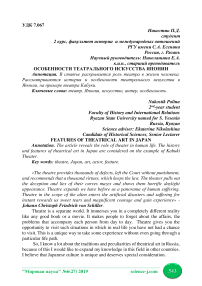Features of theatrical art in Japan
Автор: Nakostik Polina
Журнал: Мировая наука @science-j
Рубрика: Гуманитарные и общественные науки
Статья в выпуске: 6 (27), 2019 года.
Бесплатный доступ
The article reveals the role of theater in human life. The history and features of theatrical art in Japan are considered on the example of Kabuki Theater.
Theatre, japan, art, actor, feature
Короткий адрес: https://sciup.org/140264815
IDR: 140264815 | УДК: 7.067
Текст научной статьи Features of theatrical art in Japan
«The theatre provides thousands of defects, left the Court without punishment, and recommends that a thousand virtues, which keeps the law. The theater pulls out the deception and lies of their curves mazes and shows them horrific daylight appearance. Theatre expands we have before us a panorama of human suffering. Theatre in the scope of the alien enters the artificial disasters and suffering for instant rewards us sweet tears and magnificent courage and gain experience» - Johann Christoph Friedrich von Schiller .
Theatre is a separate world. It immerses you in a completely different reality like any good book or a movie. It makes people to forget about the affairs, the problems that accompany each person from day to day. Theatre gives you the opportunity to visit such situations in which in real life you have not had a chance to visit. This is a unique way to take some experience without even going through a particular life path.
So, I know a lot about the traditions and peculiarities of theatrical art in Russia, because of this I would like to expand my knowledge in this field in other countries. I believe that Japanese culture is unique and deserves special consideration.

The Japanese theatre has a deep tradition of symbolism. This can be seen in all kinds of performances: classic – But, puppet – Bunraku, unconventional – Kabuki. Kabuki is a classic art form that originated in the 17th century. In translation this name means "the art of singing and dancing" [2].
Each performance is divided into acts that can be viewed as a separate performance. Japanese theatre Kabuki differs of style productions, more similar to the European farce. The actors and the stage are arranged accordingly. The action represented to the public eye, as a rule, is exaggerated character.
The director tries to draw the viewer's attention to some feature of real life, showing its reverse, not the most beautiful side.
The specificity of Kabuki can be traced in the peculiarities of the change of scenery. Traditional theater adheres to strict rules. The scripts are written in such a way that each act of the production takes place on the same background. In Kabuki, the surroundings may change the course of the play. Actors continue to play, and workers who are dressed in black, hastily change scenery. The audience takes their work for granted, as if participating in the presentation. They do not expect that each time the curtain will be drawn, it is usually painted in three colors: red, green (or white) and black, alternating stripes [1].
Kabuki has passed a long historical path, which was accompanied by many transformations. So, over time, this genre started to be copied by many bands. They often included revealing outfits and erotic scenes. Men went crazy with beauty and grace of Actresses and often arranged duels among themselves. The ruling elite did not like this trend, so they banned women from participating in theatrical performances at the legislative level. But this did not destroy Kabuki as a species – now there began to play exclusively male actors, embodying both women and men.Of course, the decree was abolished after 2 century, but the tradition of a men who were now much more than Actresses-women. Undoubtedly, one of the features of this type of theater is the make-up of actors. Usually the hair is collects in a bun on the back of his head the silk cloth. Face, neck, nape are covered with whitewash. As a rule, rice flour was used for this purpose earlier. But there have been cases of the use of zinc oxide why the actor might have been poisoned to death [3].
Lips and eyebrows are painted with a special brush. In rare cases, make-up is applied to the eyes. Tongue can make up too, if in the course of action from the actor is required to show it. Whitewash covers all visible parts of the body: hands, wrists, legs.
The next item of makeup is kumadori is application specific, distinctive stripes on the face. They express the emotions of a human character or define a character as an animal or supernatural being.
An important role is played by costumes-they seem to recreate the era of the 17th century. Mask use is not accepted – instead, the skillful make-up is put on actors in several layers. Also they wear wigs.
Kabuki stories usually reflect important values and spiritual experiences, such as a righteous and equitable life; the Buddhist law of karma, where good is

encouraged and villains very soon feel the consequences of their own bad deeds; respect for elders; life commitments and so on.
Thus, I can say that this type of theatrical art has its own distinctive features that have been formed for several centuries. It has peculiar features in make-up and in the way the performance takes place. Not everyone will be able to perceive positively what is happening on stage. In my opinion, this kind of theater is definitely not for me. I would not be able to calmly perceive the rapid change of scenery right during the performance, because the extra turmoil is sharply evident. Also features in make-up on the one hand simplify the perception of what is happening on the stage, as on the faces draw certain emotions, but on the other hand, it is difficult for a foreigner who is not used to such shows, calmly perceive this kind of actors.
In conclusion, I would like to emphasize that there is a similar feature in theatrical productions; they are all aimed at exposing any important life values, spiritual experiences, social problems and acute issues that need to be addressed. People from the outside look at what is happening on the stage and draw conclusions that will help them to change themselves and society as a whole in the future.
Список литературы Features of theatrical art in Japan
- Гундзии Масакацу Японский театр Кабуки. - М.: Прогресс, 1969.
- Японский театр кабуки. URL: https://galitravel.ru/yaponskij-teatr-kabuki/ (09.03.2019).
- Японский театр - удивительное искусство страны восходящего солнца. URL: http://o-buddizme.ru/iskusstvo-vostoka/yaponskiy-teatr (09.03.2019).


